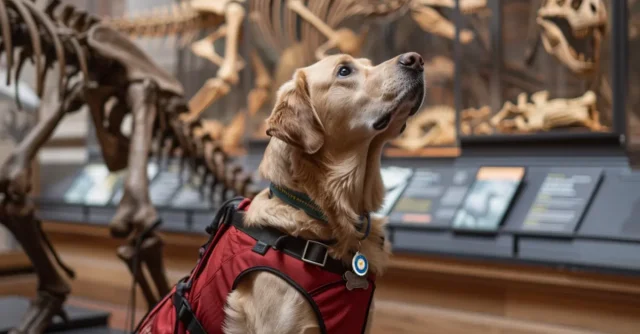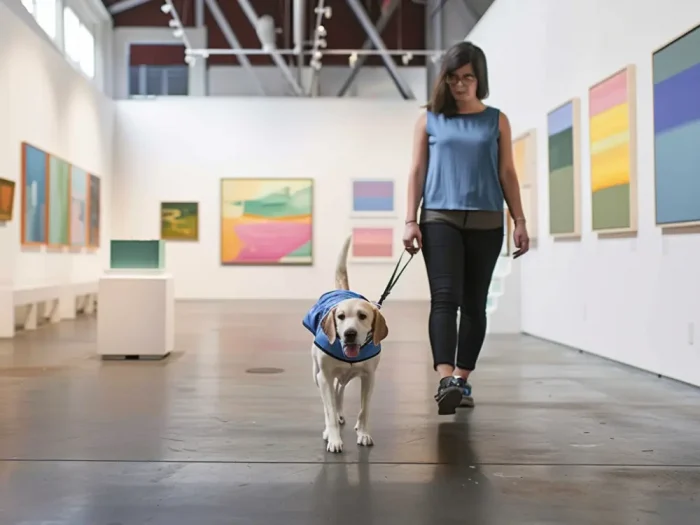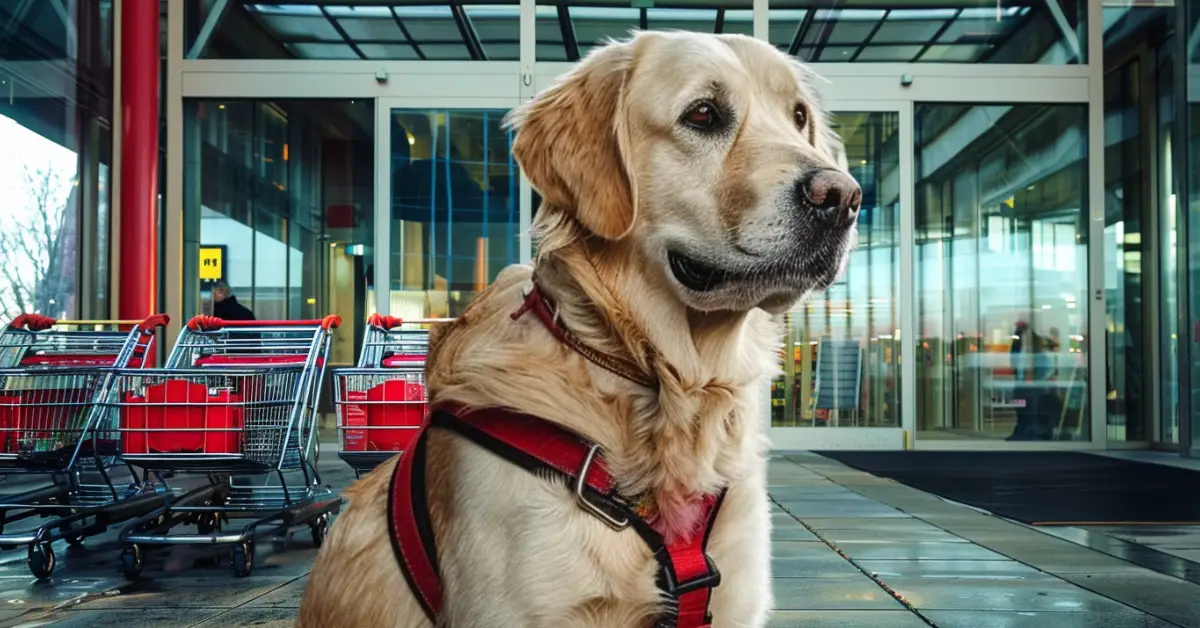Can you bring a service dog to a museum?

Yes, you can bring your service dog to the museum! All the major U.S. museums welcome guests with service animals in accordance with the Americans with Disabilities Act (ADA). There are some areas, however, that might be off-limits. Here’s what you should know if you plan to spend a day at the museum with your service animal.
In this article:
- Museum areas where service dogs may face restrictions
- Popular museums’ service dog policies
- Practical tips for museum visits with service dogs
Museum Areas Where Service Dogs May Face Restrictions
While service dogs are generally allowed throughout museums, there are some exceptions where restrictions might apply:
- Conservation laboratories: Areas where art restoration occurs often maintain controlled environments with specific air quality requirements that could be compromised.
- Interactive touch exhibits: Some hands-on exhibits involve small pieces or delicate mechanisms that could pose hazards to dogs or be damaged by them.
- Narrow pathways: Historical buildings housing museums may have extremely tight corridors or staircases where a service dog might not safely fit alongside visitors.
- Theaters and planetariums: While service dogs are allowed, museums may offer specific seating areas with more floor space for the dog to remain comfortable during presentations.
- Special exhibitions with environmental controls: Exhibits featuring light-sensitive artifacts often have extremely dim lighting that might make navigation challenging.
- Elevated platforms or observation decks: Some museums have viewing areas with grated floors that may be uncomfortable for dogs’ paws.
- Interactive virtual reality experiences: Areas where visitors wear headsets and move in confined spaces, might pose safety issues for service dog handlers.
When restrictions apply, museums can provide staff assistance as an alternative accommodation, offer a secure and comfortable area where the dog can wait briefly, or arrange for another individual to accompany the handler through restricted areas. Many museums also provide virtual tours of inaccessible spaces.

Popular Museums’ Service Dog Policies
Here are service dog policies for some of the most popular museums in the country:
Smithsonian Museums, Washington, DC
All Smithsonian museums, including the National Museum of Natural History and the National Air and Space Museum, welcome service animals as defined by the ADA. Emotional support animals aren’t permitted.
What to know:
- There’s no need to register or provide paperwork.
- You may be asked if your dog is a service animal and what task it performs, especially if the dog isn’t wearing a vest.
The Museum of Modern Art (MoMA), NYC
MoMA clearly states that trained service animals are welcome. Like the Smithsonian, they follow the ADA’s definition, which means emotional support animals do not qualify.
Extra notes:
- There are quiet areas and accessible restrooms throughout the museum.
- Staff are trained in ADA protocols, so interactions tend to be smooth and respectful.
The Art Institute of Chicago
Service animals are allowed throughout the Art Institute of Chicago. They define these animals according to the ADA and may ask the standard two questions if it’s not obvious that the dog is a service animal.
Tips for visiting:
- The museum layout is large — check in at the admission desk if you need help navigating with your dog.
- You and your dog may be asked to step aside for a quick check if there’s a security screening.
The Getty Center & Getty Villa, Los Angeles
The Getty welcomes service animals in all public spaces. Emotional support animals are not permitted.
Things to know:
- The Getty sites sprawl with outdoor areas and gardens — be prepared for various terrains.
- There are designated relief areas outside the buildings; ask a staff member if you need directions.
The Metropolitan Museum of Art, New York
The Met explicitly welcomes service animals in both the Fifth Avenue location and The Cloisters. They follow ADA guidelines and emphasize accessibility throughout the museum. Check out our guide on bringing dogs on the subway if you take public transportation.
Good to know:
- If your dog is accompanying you as a handler with a disability, your caregiver or companion may also qualify for free admission.
- The Met does not require proof of service animal status, but staff may ask ADA-compliant questions.
San Francisco Museum of Modern Art (SFMOMA)
SFMOMA permits trained service animals and clarifies that emotional support animals are not allowed. Staff are trained to ask only the two legal ADA questions if needed.
Extra accessibility perks:
- Service dogs are welcome in all exhibit spaces.
Elevators, wide galleries, and quiet zones are all part of the museum design, which makes it especially service-dog-friendly.
Practical Tips for Museum Visits with Service Dogs
Before Your Visit
- Check gallery layouts: Review museum floor plans to identify narrow spaces, crowded exhibits, and potential rest areas.
- Plan for marble and tile floors: Many museums have slippery surfaces; consider protective booties for your dog.
- Identify quiet spaces: Note locations of less-visited galleries where your dog can take mental breaks.
- Research special exhibits: Check if any current exhibitions have unusual lighting, sounds, or interactive elements.
- Locate service dog relief areas: Many prominent museums have designated outdoor spaces nearby.
During Your Visit
- Use service elevators: Ask security about using staff elevators when traveling between floors.
- Navigate strategically: Visit popular exhibits early in the day before crowds form.
- Be mindful of sound galleries: Some museums have immersive audio installations that may overwhelm service dogs.
- Watch for climate zones: Art preservation requires different temperatures between galleries; bring a light covering for your dog if needed.
- Use museum benches: Position your service dog under benches during longer viewing stops to avoid foot traffic.
- Use service dog accessories: Use service dog paraphernalia like clearly marked vests, tags, harnesses, and ID cards so staff and other patrons immediately know you have a service dog.
After Your Visit
- Check paws for damage: Museum flooring can be abrasive; inspect paws for wear.
- Allow sensory decompression: Museums are rich with visual stimuli and unfamiliar scents; give your dog quiet time afterward.
What if there’s a problem?
Most museum staff are trained in ADA compliance, but misunderstandings can still happen. Here are a few quick responses you can use if you’re challenged:
If someone says, “Pets aren’t allowed”:
You can calmly respond, “My dog is not a pet — this is my service animal, and we’re protected under the Americans with Disabilities Act.”
If they ask for papers or ID:
Just say, “Under the ADA, I’m not required to show documentation. You’re welcome to ask what task my service animal is trained to perform.”
If access is denied (rare but serious):
Ask to speak to a supervisor and consider reporting the incident to the museum’s accessibility office. You can also file a complaint through the ADA website.

About the Author: The writing team at Service Dog Certifications is made up of folks who really know their stuff when it comes to disability laws and assistance animals. Many of our writers and editors have service dogs themselves and share insights from their own experiences. All of us have a passion for disability rights and animals.
Latest Posts

How to Bring a Service Dog to Six Flags Magic Mountain
Service dogs are welcome at Six Flags Magic Mountain so long as they are, according to Six Flags, “trained to do work or perform tasks for people with disabilities.” Of course, your dog must be housebroken and remain on a leash or harness and under your control while at the park — and the park […]

Read More

When Stores Can Refuse Your Service Dog
According to the Americans with Disabilities Act (ADA), service dogs should be allowed into any store most of the time. A store owner can legally exclude a service dog if they are actively growling, snapping at, or frightening customers, or if the dog is obviously out of the control of its owner. Ordinary behaviors — […]

Read More

How Much Should I Exercise My Service Dog?
Like any dog, a service dog needs exercise. While their work to support you involves a certain amount of physical activity, there’s a good chance it’s not enough to keep your dog healthy. The amount and type of exercise needed will depend on your dog’s breed and age. Fortunately, there is a wide range of […]

Read More